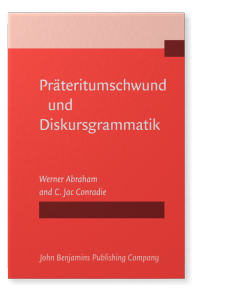Präteritumschwund und Diskursgrammatik
Präteritumschwund in gesamteuropäischen Bezügen: areale Ausbreitung, heterogene Entstehung, Parsing sowie diskursgrammatische Grundlagen und Zusammenhänge
Authors
This work demonstrates that what is commonly called preterite decay in Upper German (PS; cf. German Präteritumschwund) is in fact a phenomenon common to a great number of European languages, all of which are in areal con-tact. However, the conclusion that this is a phenomenon arising under areal influence appears clearly mistaken — not only so because it would no more than postpone the search for the real trigger of this development. It will be shown, first, that the preterite loss in the languages under inspection comes in different states of completion. It will be seen that the loss of the preterite, under this perspective, German is by no means a completed process. Second, and what is more, it will be argued that the trigger for this decay of the synthetic preterite and its replacement by analytic preterite forms is the specific criteria under which oral (as opposed to written) communication is executed. Counter to the rich, existing literature on the topic, a number of parsing principles will be claimed to be responsible for this diachronic development yielding different results due to a different execution of these principles.
[Not in series, 103] 2001. xiv, 148 pp.
Publishing status: Available | Language: German
© John Benjamins Publishing Company
Table of Contents
-
Einleitung | p. xi
-
Abstract | p. xiii
-
1. Präteritumschwund in gesamteuropäischen Bezügen | p. 1
-
2. Präteritumschwund (PS) im frühen Afrikaans | p. 25
-
3. Der oberdeutsche Präteritumsschwund unter neuer methodischer Sicht | p. 55
-
4. Parsing- und diskursprominente Eigenschaften des Deutschen | p. 67
-
5. Die Diskursfunktionen Thema — Rhema: Deutsche Grammatik zwischen Diskursprominanz und Parsingregularitäten | p. 75
-
6. Basisstruktur des deutschen Satzes unter diskursfunktionalem Gewicht: Inhaltlich-funktionale Kategorien und ableitende funktionale Kategorien | p. 97
-
7. Das Jiddische mit Präteritumschwund: SVO als Syntaxcalque aus dem Slawischen, SOV als deutsche Diskurstrategie | p. 115
-
8. Schluß zur parsing-methodischen Exerzitie über den Präteritumschwund allgemein und im Oberdeutschen im besonderen | p. 123
-
9. Nachtrag: Kurze Erläuterungen zu den Erklärthesen und Ursachenkriterien | p. 127
-
Literaturnachweise | p. 137
-
Sachindex | p. 145
“Abraham und Conradie haben eine insgesammt gelungene Arbeit vorgelegt, die den germanistischen Fragehorizont bezüglich Präteritumschwund hin auf eine typologische und allgemeinsprachwissenschaftliche Perspective öffnet und der zukünftige Forschung nicht nur auf diesem Gebiet wichtige Anregungen bieten wird. Es sei insbesondere jedem Germanisten nachdrücklich zur Lektüre empholen.”
Helmut Weiß , Universität Regensburg in Linguistische Berichte 193, 2003
Cited by (25)
Cited by 25 other publications
Šekli, Matej
Alonso Pascua, Borja
Coats, Steven
Melchior, Luca
2022. Come che al à vût dit. In From Verbal Periphrases to Complex Predicates [IVITRA Research in Linguistics and Literature, 31], ► pp. 41 ff. 
Seiler, Guido & Thilo Weber
Bidese, Ermenegildo & Alessandra Tomaselli
Eide, Kristin Melum & Marc Fryd
2021. Chapter 1. The perfect volume. In The Perfect Volume [Studies in Language Companion Series, 217], ► pp. 2 ff. 
Arkadiev, Peter M. & Björn Wiemer
2020. Chapter 5. Perfects in Baltic and Slavic. In Perfects in Indo-European Languages and Beyond [Current Issues in Linguistic Theory, 352], ► pp. 124 ff. 
De Smet, Isabeau & Freek Van de Velde
Fischer, Hanna
2019. How to get lost. In Morphological Variation [Studies in Language Companion Series, 207], ► pp. 197 ff. 
Fischer, Hanna
2020. Chapter 4. The development of the perfect in selected Middle and New Germanic languages. In Perfects in Indo-European Languages and Beyond [Current Issues in Linguistic Theory, 352], ► pp. 96 ff. 
Fischer, Hanna
Schallert, Oliver & Antje Dammel
2019. Introduction. In Morphological Variation [Studies in Language Companion Series, 207], ► pp. 1 ff. 
Matić, Dejan & Irina Nikolaeva
2018. From polarity focus to salient polarity. In The Grammatical Realization of Polarity Contrast [Linguistik Aktuell/Linguistics Today, 249], ► pp. 9 ff. 
Weber, Kathrin
2018. Tense and aspect marking in (Low) German perfect constructions based on variety contact. In Constructions in Contact [Constructional Approaches to Language, 24], ► pp. 115 ff. 
Abraham, Werner
2014. The Upper German differential. In Bavarian Syntax [Linguistik Aktuell/Linguistics Today, 220], ► pp. 305 ff. 
Abraham, Werner
2019. What are the guiding principles in the evolution of language: Paradigmatics or syntagmatics?. Evolutionary Linguistic Theory 1:2 ► pp. 109 ff. 
Abraham, Werner & Jadwiga Piskorz
2014. A rare case of covert modality. In Modes of Modality [Studies in Language Companion Series, 149], ► pp. 409 ff. 
Bucciarelli, Paola, Ramona Bongelli, Andrzej Zuczkowski, Sibilla Cantarini & Christine Berthold
2014. Uncertainty markers in a corpus of German biomedical papers from Spektrum der Wissenschaft (1993-2012). In Communicating Certainty and Uncertainty in Medical, Supportive and Scientific Contexts [Dialogue Studies, 25], ► pp. 341 ff. 
Gaeta, Livio
2014. On decategorization and its relevance in German. In Word Classes [Current Issues in Linguistic Theory, 332], ► pp. 227 ff. 
Schallert, Oliver
2014. IPP-Constructions in Alemannic and Bavarian in comparison. In Bavarian Syntax [Linguistik Aktuell/Linguistics Today, 220], ► pp. 247 ff. 
McWHORTER, J. H.
Sapp, Christopher D.
Smith, Aaron
[no author supplied]
This list is based on CrossRef data as of 22 june 2024. Please note that it may not be complete. Sources presented here have been supplied by the respective publishers. Any errors therein should be reported to them.
Subjects
Main BIC Subject
CF: Linguistics
Main BISAC Subject
LAN009000: LANGUAGE ARTS & DISCIPLINES / Linguistics / General
